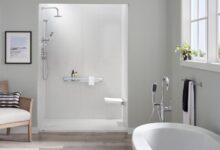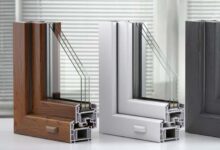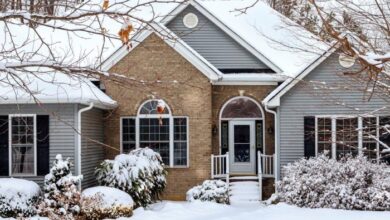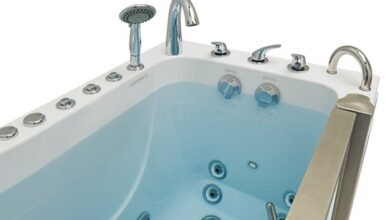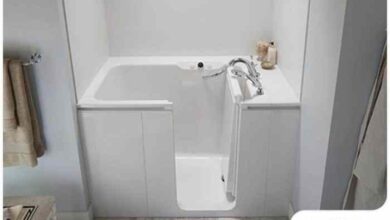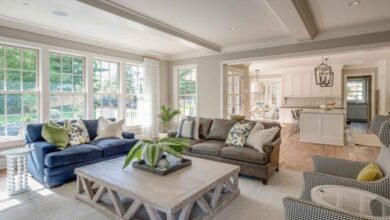Durable Siding Options A Comprehensive Guide
Durable Siding Options: Choosing the right siding for your home is a crucial decision, impacting both its aesthetic appeal and long-term durability. This guide dives deep into the world of exterior cladding, exploring various materials, their pros and cons, installation complexities, maintenance needs, environmental impact, and ultimately, helping you make an informed choice that perfectly suits your needs and budget.
We’ll unpack the intricacies of each option, from the classic charm of wood to the modern resilience of fiber cement, ensuring you’re equipped to navigate this often-overlooked aspect of home improvement.
We’ll analyze everything from the manufacturing processes and aesthetic qualities of different siding materials to their long-term durability, maintenance requirements, and environmental impact. We’ll also cover cost considerations, installation complexities, and even offer a decision-making flowchart to help you navigate the selection process. By the end, you’ll be able to confidently choose the siding that best complements your home’s style, climate, and budget, while minimizing your environmental footprint.
Types of Durable Siding
Choosing the right siding for your home is a significant investment, impacting both its aesthetic appeal and long-term durability. Understanding the various options available, their strengths and weaknesses, and their expected lifespan is crucial for making an informed decision. This section delves into the specifics of several popular durable siding materials, providing a comprehensive overview to aid in your selection process.
Durable Siding Materials: A Detailed Comparison
Selecting the ideal siding material requires careful consideration of several factors. The following table summarizes the key characteristics of popular choices, offering a concise comparison to aid in your decision-making process. Remember that actual lifespan can vary based on climate, maintenance, and installation quality.
| Material | Pros | Cons | Average Lifespan (Years) |
|---|---|---|---|
| Vinyl | Affordable, low maintenance, variety of colors and styles, easy installation. | Can fade or warp in intense sun, susceptible to damage from impact, less durable than other options. | 20-40 |
| Fiber Cement | Durable, fire-resistant, low maintenance, realistic wood-like appearance. | More expensive than vinyl, requires professional installation, heavier than vinyl, can be susceptible to moisture damage if not properly installed. | 50-80 |
| Wood | Classic aesthetic appeal, can be painted or stained, relatively easy to repair. | High maintenance (requires regular painting/staining and sealing), susceptible to rot, insect damage, and fire. | 20-50 (depending on wood type and maintenance) |
| Aluminum | Lightweight, durable, resistant to rot and insect damage, recyclable. | Can dent easily, susceptible to scratches, may not be as aesthetically pleasing as other options, can be noisy in heavy rain. | 40-60 |
| Steel | Extremely durable, fire-resistant, impact-resistant, low maintenance. | Expensive, can dent, prone to rust if not properly coated, can be noisy in heavy rain. | 50-100 |
Manufacturing Processes and Composition
The manufacturing process significantly influences a siding material’s durability and performance. Vinyl siding, for example, is extruded from polyvinyl chloride (PVC) resin, creating a relatively lightweight and weather-resistant product. Fiber cement siding, conversely, is a composite material made from a mixture of cement, cellulose fibers, and other additives, resulting in a much denser and more robust product. Wood siding, depending on the species, undergoes various treatments to enhance its resistance to rot and insect damage.
Aluminum siding is manufactured by rolling and forming aluminum sheets, often with a protective coating to enhance its durability and appearance. Steel siding undergoes a similar process, with additional emphasis on protective coatings to prevent rust and corrosion. These distinct manufacturing processes directly impact the final product’s characteristics, including its strength, longevity, and aesthetic qualities.
Aesthetic Qualities and Options, Durable Siding Options
The visual appeal of siding is a key factor in many homeowners’ decisions. Vinyl siding offers a vast array of colors and styles, often mimicking the look of wood or stone at a fraction of the cost. Fiber cement siding can also provide a realistic wood-grain texture and is available in a range of colors. Wood siding, of course, offers a classic and natural aesthetic, with numerous species and finishes to choose from.
Aluminum siding typically presents a more modern, clean look, although it can be painted to match other architectural features. Steel siding often resembles aluminum in its appearance, although it is available in a wider range of colors and finishes. Ultimately, the choice depends on personal preference and the overall architectural style of the home. Consider the potential for color fading and how the siding will complement your home’s design.
Durability and Maintenance

Choosing the right siding isn’t just about aesthetics; it’s a long-term investment impacting your home’s value and curb appeal for decades. Understanding the durability and maintenance requirements of different siding materials is crucial for making an informed decision. This section delves into the longevity, resilience, and upkeep associated with popular siding choices, empowering you to select the best option for your needs and budget.
Durability of Common Siding Materials
The lifespan and resilience of siding vary considerably depending on the material. Factors such as weather exposure (sun, rain, snow, and extreme temperatures), impact resistance (from hail or accidental damage), and susceptibility to pests and rot all play a significant role. Understanding these factors allows for more accurate cost projections and informed maintenance planning. For example, a home in a hurricane-prone area will require a significantly more durable siding material than one in a mild climate.
Maintenance Procedures for Various Siding Types
Regular maintenance is key to extending the life of your siding and preserving its appearance. Neglecting upkeep can lead to costly repairs down the line. The frequency and type of maintenance needed will differ based on the material.
Vinyl Siding Maintenance
Vinyl siding is known for its low maintenance, but that doesn’t mean it’s entirely carefree. Regular cleaning is essential to prevent dirt and grime buildup, which can dull its appearance and potentially damage the surface over time.
- Cleaning: Wash vinyl siding annually with a mild detergent and water solution using a soft-bristled brush or sponge. Avoid high-pressure washers, which can damage the siding.
- Repair: Minor scratches or dents can often be addressed with touch-up paint. More significant damage may require replacing individual panels.
- Repainting: Vinyl siding typically doesn’t require repainting, but if discoloration occurs, a specialized vinyl paint can be used.
Wood Siding Maintenance
Wood siding offers a classic and aesthetically pleasing look, but it requires more diligent maintenance than vinyl. Wood is susceptible to rot, insect infestation, and weathering, necessitating regular inspections and upkeep.
- Cleaning: Clean wood siding periodically with a gentle detergent and water solution, followed by rinsing thoroughly. Consider using a pressure washer (low pressure) for stubborn dirt but exercise caution to avoid damage.
- Repair: Repair or replace damaged or rotten boards promptly. Caulk any gaps or cracks to prevent water intrusion.
- Repainting/Sealing: Regular repainting and sealing (every 3-5 years, depending on climate) is crucial to protect the wood from the elements and extend its lifespan. Choose high-quality exterior-grade paint and sealant.
Fiber Cement Siding Maintenance
Fiber cement siding boasts exceptional durability and weather resistance. However, while it requires less frequent maintenance than wood, regular inspections are still vital.
- Cleaning: Wash fiber cement siding annually with a mild detergent and water solution. A soft brush or sponge is recommended.
- Repair: Minor chips or cracks can be repaired with specialized patching compounds. Major damage may require panel replacement.
- Repainting: Repainting may be needed every 10-15 years, depending on exposure and desired aesthetics. Use exterior-grade paint suitable for fiber cement.
Common Siding Problems and Solutions
Ignoring minor issues can quickly escalate into significant and costly repairs. For example, a small crack in wood siding, if left untreated, can allow water penetration, leading to rot and extensive damage. Similarly, neglecting to clean vinyl siding can lead to persistent staining and discoloration. Proactive maintenance, including regular inspections and prompt repairs, is crucial for preventing such problems.
Early detection and timely intervention are key to minimizing repair costs and maximizing the lifespan of your siding. Regular cleaning and preventative maintenance are your best defenses against costly repairs down the road. Think of it as preventative maintenance—an ounce of prevention is worth a pound of cure.
Cost and Installation
Choosing the right siding isn’t just about aesthetics; the total cost, encompassing materials and labor, significantly impacts your budget. Understanding the installation process for each siding type is equally crucial, as it influences both the final cost and the project timeline. Let’s delve into the financial and logistical aspects of siding installation.
Siding costs vary wildly depending on the material, its quality, the size of your house, and your geographic location. Labor costs also fluctuate regionally and are influenced by the complexity of the job. A simple, flat-surface installation will be cheaper than one involving intricate detailing or significant repairs to the underlying structure. Remember, these are estimates, and obtaining multiple quotes from reputable contractors is essential for accurate pricing.
Siding Material Costs and Installation Complexity
The table below provides a general cost range per square foot for various siding materials. These figures include both material and labor costs and are intended as a guideline. Actual costs may vary significantly based on the factors mentioned previously. Consider these ranges a starting point for your budgeting process. Always consult local contractors for precise quotes tailored to your specific project.
| Siding Material | Cost per Square Foot (USD) | Installation Complexity |
|---|---|---|
| Vinyl | $3-$8 | Relatively easy; DIY possible for simpler projects. |
| Fiber Cement | $7-$15 | Moderate complexity; professional installation often recommended. |
| Wood | $10-$25+ | High complexity; requires skilled labor; significant maintenance. |
| Metal | $10-$20+ | Moderate to high complexity; professional installation preferred; can be challenging in extreme weather. |
| Brick | $15-$30+ | Very high complexity; requires specialized skills and tools; significantly longer installation time. |
Installation Processes for Different Siding Types
The installation process varies significantly depending on the siding material. Each type requires specific tools and techniques, influencing both the time and skill level needed for proper installation. Improper installation can lead to costly repairs down the line, so it’s crucial to choose the right approach for your chosen material.
For instance, vinyl siding installation typically involves nailing pre-cut panels to furring strips, ensuring proper overlap and alignment. Fiber cement siding, while offering superior durability, demands more precise cuts and fastening, often requiring specialized tools. Wood siding installation is labor-intensive, demanding careful measurement, cutting, and treatment to prevent rot and insect infestation. Metal siding installation, often involving interlocking panels, may necessitate specialized tools and experience in handling metal sheeting.
Brick siding, of course, involves a far more complex masonry process.
Installation Time and Difficulty Comparison
Installation time is directly related to the siding material and the complexity of the project. A small house with simple vinyl siding can be completed in a few days by experienced installers, whereas a large house with intricate brickwork might take weeks or even months. The difficulty level also varies significantly; vinyl siding is often considered a DIY-friendly option for simpler projects, while other materials necessitate professional expertise to ensure proper installation and longevity.
For example, a 1,500 square foot house with vinyl siding might take a crew of two professionals 2-3 days, while the same house with fiber cement could take 5-7 days. Brick siding on the same house would likely take several weeks. These are estimates and actual times can vary depending on weather, site conditions, and the skill of the installation crew.
Environmental Impact
Choosing durable siding isn’t just about aesthetics and longevity; it significantly impacts the environment. The manufacturing process, material lifespan, and disposal methods of different siding options all contribute to their overall environmental footprint. Understanding these factors is crucial for making an informed decision that aligns with your sustainability goals. Let’s delve into the ecological considerations of popular siding materials.
The environmental impact of siding materials is multifaceted, encompassing energy consumption during manufacturing, transportation emissions, material longevity impacting replacement frequency, and end-of-life disposal challenges. A holistic assessment considers the entire lifecycle, from cradle to grave, to accurately gauge the true environmental cost.
Manufacturing Processes and Energy Consumption
The energy intensity of manufacturing varies considerably across siding materials. Vinyl siding, for example, relies heavily on fossil fuels during its production, resulting in a higher carbon footprint compared to some alternatives. Fiber cement, while requiring energy for its production, often incorporates recycled materials, partially offsetting its energy demand. Wood siding, sourced from sustainably managed forests, can have a lower carbon footprint if harvested responsibly, but deforestation remains a concern if sourcing is not carefully considered.
The energy required to transport materials from manufacturing facilities to construction sites also contributes to the overall environmental impact, favoring locally sourced materials whenever possible. For instance, a study by the University of California, Berkeley, showed that locally sourced wood siding had a significantly lower transportation-related carbon footprint compared to vinyl siding shipped across the country.
Material Lifespan and Replacement Frequency
A material’s lifespan directly influences its environmental impact. Longer-lasting siding reduces the need for frequent replacements, minimizing waste and associated emissions. High-quality vinyl siding can last for several decades, while some wood sidings might require more frequent maintenance or replacement due to rot or insect damage. Fiber cement, known for its durability and resistance to pests and rot, often boasts a longer lifespan than wood, reducing the overall environmental impact over its service life.
Enhance your insight with the methods and methods of Insulated Siding for Better Insulation.
This longevity aspect is crucial in minimizing the environmental burden over the long term. For example, a home with fiber cement siding might only require replacement once every 50 years, compared to wood siding needing replacement every 20 years.
Disposal Methods and Recyclability
End-of-life management of siding materials is another critical environmental consideration. Vinyl siding, while often durable, presents disposal challenges due to its non-biodegradable nature. Recycling options for vinyl siding are limited in many areas, leading to landfill accumulation. In contrast, some wood sidings can be repurposed or used for other applications, reducing their environmental impact. Fiber cement siding, although not directly recyclable in the same way as some metals, can often be crushed and used as aggregate in construction projects, diverting it from landfills.
The availability of recycling infrastructure and disposal programs significantly influences the overall environmental footprint of each siding material. For instance, cities with robust construction waste recycling programs might offer more options for responsible disposal of fiber cement, thus minimizing its landfill impact.
Sustainability and Recycled Content
The use of recycled content in siding manufacturing is a key indicator of sustainability. Some fiber cement siding manufacturers incorporate recycled materials in their production process, reducing the demand for virgin resources. The percentage of recycled content varies depending on the manufacturer and product line. Similarly, some wood siding manufacturers source timber from sustainably managed forests, certified by organizations like the Forest Stewardship Council (FSC), ensuring responsible forest management practices.
These sustainable sourcing and manufacturing practices contribute to a lower overall environmental impact. For example, a fiber cement siding product containing 20% recycled content would have a lower environmental footprint than a similar product with no recycled content.
Carbon Footprint Comparison
Directly comparing the carbon footprint of different siding materials requires comprehensive lifecycle assessments (LCAs). These assessments consider all stages of a product’s life, from raw material extraction to disposal. While precise figures vary depending on factors like manufacturing processes, transportation distances, and disposal methods, generally, wood siding from sustainably managed forests tends to have a lower carbon footprint than vinyl siding.
Fiber cement siding occupies a middle ground, depending heavily on the specific manufacturing processes and the percentage of recycled content incorporated. Independent studies and reports from organizations like the Environmental Protection Agency (EPA) often provide data on the comparative carbon footprints of building materials, offering valuable insights for informed decision-making. However, it’s crucial to consult the most recent and relevant data available, as manufacturing processes and technologies are constantly evolving.
Choosing the Right Siding: Durable Siding Options
Selecting the perfect siding for your home is a crucial decision, impacting both its aesthetic appeal and long-term durability. This choice isn’t merely about picking a color; it’s about understanding the interplay of factors that will best suit your home, climate, and budget. Making an informed decision requires a systematic approach, carefully considering several key elements.
A Decision-Making Flowchart for Siding Selection
A structured approach simplifies the selection process. The following flowchart guides you through the key considerations, leading to a well-informed decision. Begin by assessing your budget. If budget is severely limited, options like vinyl or aluminum might be prioritized. If budget is less of a constraint, higher-end options like fiber cement or wood become viable.
Next, consider your climate. Harsh weather conditions necessitate durable materials like fiber cement or engineered wood. Milder climates offer greater flexibility in material choices. Finally, align your chosen material with your home’s architectural style and your personal aesthetic preferences.
Climate Considerations in Siding Selection
Climate plays a significant role in siding longevity and performance. Homes in regions with extreme temperature fluctuations, heavy rainfall, or frequent snowfall require siding materials resistant to moisture damage, warping, and cracking. For example, fiber cement siding, with its superior resistance to moisture and impact, proves ideal for coastal areas prone to hurricanes or areas with harsh winters.
In contrast, warmer, drier climates might allow for a wider range of options, potentially including wood siding, provided it’s properly maintained. Consider the specific challenges your local climate presents – intense sun, heavy snow loads, or high humidity – to make an informed decision.
Budgetary Constraints and Siding Choices
Budget significantly influences siding selection. Vinyl siding presents a cost-effective option, offering a wide range of colors and styles. However, its durability and longevity may be less than more premium materials. At the higher end of the spectrum, materials like cedar wood or stone offer superior aesthetics and longevity but come with a considerably higher price tag.
Understanding your budget constraints early in the process allows you to focus on options within your financial reach. For instance, a homeowner with a limited budget might prioritize vinyl or aluminum siding, while a homeowner with a larger budget might consider the more expensive, yet longer-lasting, fiber cement or brick options.
Aesthetic Preferences and Architectural Styles
The visual impact of siding significantly influences a home’s curb appeal. Consider your home’s architectural style when choosing siding. A traditional Victorian home might be beautifully complemented by wood siding, while a modern, minimalist design might pair well with sleek metal panels. Similarly, a rustic farmhouse style might look stunning with stone or clapboard siding. Exploring various siding options and visualizing their impact on your home’s overall appearance is crucial.
Consider color palettes, textures, and the overall aesthetic you aim to achieve. Imagine a charming craftsman-style bungalow with rich, warm-toned cedar shake siding, or a contemporary home with clean lines accentuated by smooth, gray fiber cement panels. These visuals will help guide your decision.
Home Examples Illustrating Siding Choices
Consider a Cape Cod style home, characterized by its symmetrical design and low-pitched roof. Imagine this home clad in white clapboard siding, creating a classic, timeless aesthetic perfectly suited to the architectural style. The white siding provides a crisp, clean look that complements the home’s simple lines. Now, picture a ranch-style home, typically characterized by its single-story design and sprawling layout.
Visualize this home with durable, textured vinyl siding in a warm earth tone, reflecting its informal, comfortable character. The vinyl siding’s versatility in color and texture allows for a wide range of design possibilities. Finally, envision a modern farmhouse with a combination of board and batten siding, accented by dark gray metal panels. This combination of materials creates a striking contrast, highlighting the home’s contemporary features while maintaining a sense of rustic charm.
The interplay of textures and colors creates a visually appealing and cohesive design.
Closure
Selecting durable siding is a multifaceted process, demanding careful consideration of aesthetics, longevity, maintenance, and environmental impact. This guide has provided a detailed exploration of various siding materials, equipping you with the knowledge to make a well-informed decision. Remember to weigh the pros and cons of each option against your specific needs and budget, ensuring a choice that enhances your home’s value and curb appeal for years to come.
Don’t hesitate to consult with professionals for personalized advice tailored to your unique circumstances. The right siding choice can significantly impact your home’s overall value and enjoyment; choosing wisely is an investment in your property’s future.

